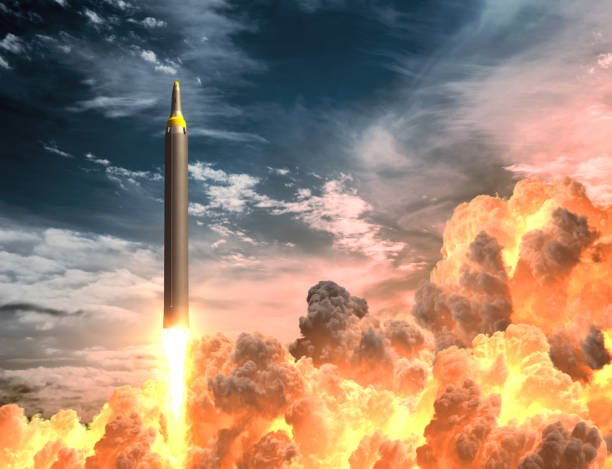Seoul and Tokyo —According to a South Korean government source, North Korea's alleged launch of its most potent intercontinental ballistic missile (ICBM) failed on Thursday morning as Pyongyang increased its battery of missile tests against the backdrop of US and South Korean military drills that were supposed to end on Friday.
According to a statement from the South Korean Air Force, Washington and Seoul decided to continue those extensive training exercises within hours of the alleged failed test because "it was necessary to demonstrate a solid combined defense posture of the bilateral alliance under the current security crisis, heightened by North Korea's provocations."
According to the US Defense Department, the combined exercises, called "Vigilant Storm," started on Monday and feature 240 aircraft and "thousands of service members" from both nations.
This week, North Korea made statements objecting to those drills before escalating tensions on the peninsula by conducting a flurry of nuclear tests on Wednesday and Thursday.
North Korea fired at least one unidentified ballistic missile into the waters off its east coast later on Thursday, according to the Joint Chiefs of Staff of South Korea, just before US Defense Secretary Lloyd Austin and his South Korean colleague Lee Jong-sup met there.
Suspected ICBM test
According to Japan's Defense Ministry, the suspected ICBM was launched from North Korea's west coast at around 7:39 a.m. local time and traveled roughly 750 kilometers (466 miles) before crashing into the Sea of Japan, also known as the East Sea, east of the Korean Peninsula.
Officials believe it to be a Hwasong-17, North Korea's most sophisticated intercontinental ballistic missile, which was successfully launched for the first time on March 24.
With the highest altitude and longest duration of any North Korean missile test ever, that launch set a new benchmark for Pyongyang. According to a report from the Korean Central News Agency at the time, the missile traveled 1,090 kilometers (681 miles) and reached a maximum altitude of 6,248.5 kilometers (3,905 miles). The report also stated that the trip lasted 68 minutes.
The missile that was launched on Thursday, according to a South Korean government source who spoke to CNN, appeared to have failed after the second stage and fell into the sea between the Korean Peninsula and Japan. According to Japan's Defense Ministry, the launch on Thursday achieved a maximum altitude of around 2,000 kilometers (1,242 miles), which is less than a third of the record height set in March.

The presumptive launch of the ICMB in Japan prompted advisories to seek refuge in the northern Miyagi, Yamagata, and Niigata prefectures, where the office of the Japanese Prime Minister initially stated it was anticipated to fly over. The missile did not cross over Japan, according to a later evaluation by the Japanese Defense Ministry.
South Korea and Japan claim that North Korea launched two short-range ballistic missiles after its rumored ICBM test on Thursday.
Pyongyang's repeated ballistic missile launches, according to a statement from South Korea's Joint Chiefs of Staff (JCS), "are a major provocation that affects the peace and stability of not just the Korean Peninsula but also the worldwide community."
The spokesperson for the US National Security Council, Adrienne Watson, said in a statement on Thursday that Washington "strongly condemns" North Korea's ballistic missile tests because they "flagrantly violate multiple UN Security Council resolutions, needlessly escalate tensions, and pose a risk of destabilizing the security situation in the region."
The rockets of North Korea
According to North Korean official media, the Hwasong-17 is a "strong nuclear war deterrent."
There are many questions regarding the missile's capacity to deliver a nuclear payload on target, but it could conceivably put the whole US mainland within range of a North Korean nuclear bomb.
However, analysts claim that it is large enough to accommodate one or even more nuclear warheads.

According to a CNN count, Thursday's launches bring the total number of North Korean missile tests this year to at least 30, although the number of individual missiles is much higher.
Both cruise missiles and ballistic missiles, which have made up the vast majority of North Korea's tests this year, were among the weapons fired.
These two kinds of missiles differ significantly from one another.
A ballistic missile is propelled into space by one or more rockets, leaves Earth's atmosphere, glides across space before reentering, and then descends to its target using just gravity as power.
A cruise missile has control surfaces reminiscent of an airplane's and is propelled by a jet engine while flying inside Earth's atmosphere.
Since cruise missiles' payloads are lower than those of ballistic missiles, they would need a smaller nuclear warhead than a missile like an intercontinental ballistic missile, which is intended to strike the continental United States.
North Korea is prohibited from testing ballistic missiles by resolutions of the UN Security Council, but there is no equivalent prohibition on the testing of cruise missiles.
It is unknown whether North Korea is capable of mounting a nuclear warhead on any form of the missile.

Record the number of short-range missiles fired each day
According to the South Korean Defense Ministry, North Korea fired at least 23 short-range missiles of various types toward the east and west of the Korean Peninsula on Wednesday.
According to the JCS, it was the most short-range missile fired by North Korea in a single day and included a ballistic missile that touched down quite near South Korean territorial waters for the first time since the division of Korea.
That missile landed in international waters some 26 kilometers south of the Northern Limit Line (NLL), the de facto inter-Korean maritime border that North Korea does not acknowledge, 167 kilometers (104 miles) northwest of the Ulleung island in South Korea.
The same amount of space north of the NLL was the target of three air-to-surface missiles fired by Seoul on Wednesday from F-15K and KF-16 fighter fighters.

Japanese Prime Minister Fumio Kishida told reporters on Wednesday that North Korea is firing missiles at an "unprecedented high frequency."
Linda Thomas-Greenfield, the US ambassador to the UN, denounced North Korea's extraordinary missile launch.